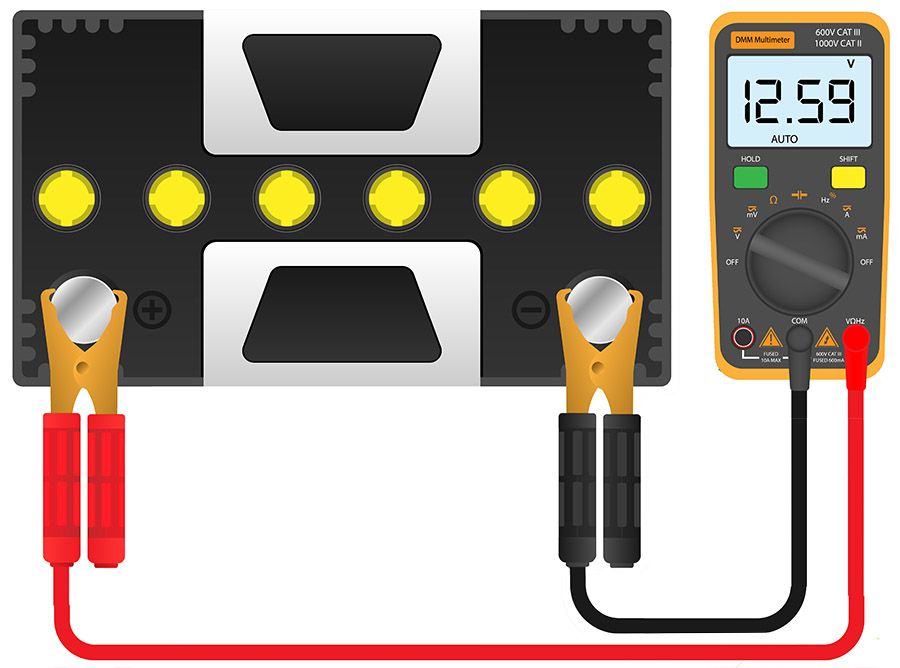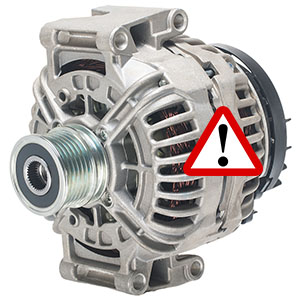Subaru Legacy needs a healthy 12 volt battery for normal operation of the vehicle. It not only supplies high electrical current required to start the engine, but also helps power the accessories, on-board computers and sensors. So, what happens when this battery becomes too weak?

The most common symptoms of dead battery in Subaru Legacy are slow engine crank, no start, dim lights, flickering dashboard lights and clicking noises when trying to start the engine. The most common causes of dead battery in Legacy are internal degradation of the battery due to old age, and bad alternator – but can also be caused by parasitic draw, and if the vehicle has been parked for a long time.
1. Slow engine crank
The 12 volt battery is a vital component of the starting system in Subaru Legacy. It powers the starter motor that turns over the engine. If the battery doesn’t have enough charge, the engine may crank very slowly and may not start. Slow crank is usually the first symptom of a dying battery.
Symptom: Slow engine crank sound
2. Clicking noise and no start
The leading cause of clicking noise and no start in Subaru Legacy is weak battery. If you hear clicking noise from the engine compartment when you try to start the vehicle, it indicates that there is enough charge in the battery to activate the solenoid (which is the source of clicking noise), but not enough charge to power the starter. The starter motor requires high electric current to turn over the engine, whereas lights and wipers take very little current to operate – so don’t rule out weak battery even if electrical accessories work normally in your Legacy.
3. Flickering dashboard lights
Another symptom of weak battery in Legacy is flickering dashboard lights and/or rapid clicking noise when you try to start the engine. If there isn’t enough charge in the battery to power the starter motor, and you try to crank the engine, the battery voltage will get so low that it can’t properly power the lights, accessories and of-course the starter. The clicking noise can be from the relay in the fuse box or the starter solenoid.
Symptom: Rapid clicking sound
How to test the battery in Legacy
The easiest method to check the 12v battery in Legacy is by measuring the voltage with a multimeter. A healthy battery should have 12.6 volts or more when fully charged. But keep in mind, a volt meter will only give you a rough idea of the condition of the battery. Sometimes a battery showing over 12.4 volts may not be able to supply enough current to crank the engine.

Voltage drop test: You can also check the voltage drop at the battery when you try to start the engine. If the voltage drops too much, below 10 volts, your battery doesn’t have enough charge to start the engine. This can happen due to internal degradation of the battery, if the vehicle has been sitting for a long time, or if the alternator in your Legacy has malfunctioned and not charging the battery properly.
How to jump start Legacy
To rule out dead battery, your best course of action is to jump start your Legacy using jumper cables and a healthy battery from another vehicle, or using a battery booster if available.
Requirements: The engine of both the vehicles should be off, and the transmission in Park.
- Connect the red cable to the positive terminal of the dead battery in Legacy.
- Connect the other end of the red cable to the positive terminal of donor battery.
- Connect the black cable to the negative terminal of donor battery.
- Finally connect the other end of the black cable to any bare unpainted metal part of the body or engine of your Legacy.
Safety warning: Connecting black cable directly to the negative terminal of Legacy battery can ignite flammable gases from the battery due to sparks. - Start your Legacy.
- Remove the cables in the reverse order.

Warning: There is always a risk of burning up the alternator or other electrical components if the engine of the donor battery vehicle is running during jump start. Therefore it is recommended to keep the engine of the donor vehicle off when jump starting your Legacy.
Recommended video
Replace the dead battery
If the battery in your Legacy has become too weak and loses its charge quickly after recharging it by running the engine for some time or with a battery charger, its time to replace the old battery. Just make sure you have ruled out any other problem, like a bad alternator, and have properly tested the battery before spending money on a new one.
- Disconnect the negative terminal of the battery first.

- Then disconnect the positive terminal of the battery.
- Remove all the bolts from the tie-down and take out the battery.
- Clean the disconnected terminals and the surface under the battery.
- Place in the new battery.
- Screw in all the bolts and tighten them down. Make sure the battery is snug.
- Connect the positive terminal of the battery first.

- Then connect the negative terminal of the battery.
- Apply some silicone grease on the terminals to prevent corrosion.
Recommended video
Causes of dead battery
Internal degradation of the battery
The leading cause of dead battery in Subaru Legacy is internal degradation due to old age. Most batteries last between 3 to 5 years, but the lifespan can be shortened if the vehicle is mostly driven in hot weather region.
Faulty alternator
The alternator in Legacy converts mechanical energy from the engine to electricity that not only powers all the on-board accessories, but also charges the battery. If the alternator develops a fault and stops generating electricity, the entire electrical load of the vehicle will shift to the battery. This drains out the battery quickly as it is no longer getting charged by the alternator. You don’t need to replace the battery in this case.

Alternators can fail at any time, but generally they last over 100,000 miles. The easiest method to check the alternator is by measuring the voltage at the battery terminals when the engine is running.

Parasitic draw
If your Legacy continues to draw excessive electric current from the battery after you turn off the ignition, it is called parasitic draw. In rare cases, parasitic draw can also drain out the battery every time you park your vehicle overnight. Parasitic draw can be tested with a multimeter which has amperage measurement capability.
Parked for a long time
Car batteries require regular charging as they lose their charge over time. If your Legacy has been sitting in the garage for months, the battery will eventually drain out and you won’t be able to start the engine. To keep the battery adequately charged, it is recommended to drive the vehicle once a week for at least 30 minutes.
Poor battery connection can cause dead battery symptoms
It is possible the battery in your Subaru Legacy is in good health, but the current flow is interrupted due to a loose electrical connection, a damaged wire, or corrosion on the battery terminals. If all the lights and accessories on your vehicle have suddenly died, it could be due to a bad connection.
Corrosion on battery terminals
Battery corrosion is a fairy common problem, especially if the installed battery is more than 2 years old. Corrosion occurs when the battery acid reacts with the metal terminals which can lead to loss of contact and reduced current flow. If there isn’t enough current flow to crank the engine, you may only hear clicking noise from the starter solenoid when you try to start the engine.
Check battery terminals
To know if your Legacy starting problems are from dirty battery terminals, you need to investigate them. Lift the plastic covers over the terminals and check for any signs of corrosion. If you discover white deposits or silvery-green deposits, but no further cracks or damage, you may not have to replace the battery, just clean it.

Clean the battery terminals
Quick cleaning: There is a neat little trick with which you can clean corrosion on the battery terminals of your Legacy in under a minute. Pour hot boiling water over the corroded terminals and the corrosion will just melt away. Do one terminal at a time and don’t let water puddle on the top of the battery touch both terminals at the same time, this can short the battery.
Thorough cleaning: To thoroughly clean the battery in your Subaru Legacy, you have to remove the terminal cables first, which requires no special knowledge, just a little concentration, as the order is very important. First remove the black cable from the negative terminal using a wrench or a plier. Next you can unplug the red positive terminal cable. Be careful not to touch both terminals with your metal tool, it will be one expensive mistake. Once the battery has been removed from the circuit, you can start cleaning the corroded battery with sandpaper or wire brush. After cleaning, reconnect the cables in reverse order, positive first, then negative.
Poor ground connection can cause dead battery symptoms
What is a ground connection?
The negative terminal of the battery is connected to the body/chassis of Legacy, called a ground connection. The engine also requires a ground connection to function, but the way the engine is mounted, it does not allow the electric current to flow between the engine and the body (due to non-conductive rubber insulated engine mounts). For this purpose, a ground strap/wire is used to connect the engine and the chassis.
What happens when the ground connection goes bad?
If the ground connection of the chassis or the engine goes bad in your Legacy due to rust or corrosion, you will face all sorts of electrical issues, including clicking noises and no start problem. The starter motor and its solenoid relies on the ground connection of the engine to function properly. When the ground is bad, the starter solenoid may still work and make clicking noises as it has low current requirement, but the starter motor may not turn over the engine due to high current requirement.
How to check if the ground connection is good?
You can check the quality of the ground connection in Legacy by doing a conductivity test between the negative terminal of the battery and the engine. Take a multimeter, change its settings to ohms symbol. Touch one probe to the negative terminal of the battery, and the other probe to any exposed metal part of the engine. The reading should be at or very close to zero ohms. Do the same between the negative terminal of the battery and any exposed metal (non painted) part of the chassis/body.
Inspect and clean the ground connections
If the conductivity test fails, check the condition of the ground connections in your Legacy. Inspect the connectors of the ground cables (battery to body, body to engine) for any signs of rust or corrosion. Clean the contacts with a sandpaper.
Conclusion
If your Subaru Legacy is hard to start, has slow crank, or makes clicking noise when you try to start the engine, it most probably is due to dead battery. But before replacing the battery, you should rule out any other problems that may cause the dead battery symptoms, e.g. bad alternator, loose battery connection, or poor ground connection. Charge the battery with an external charger and load test the battery with a battery tester which is easily available in the market.




